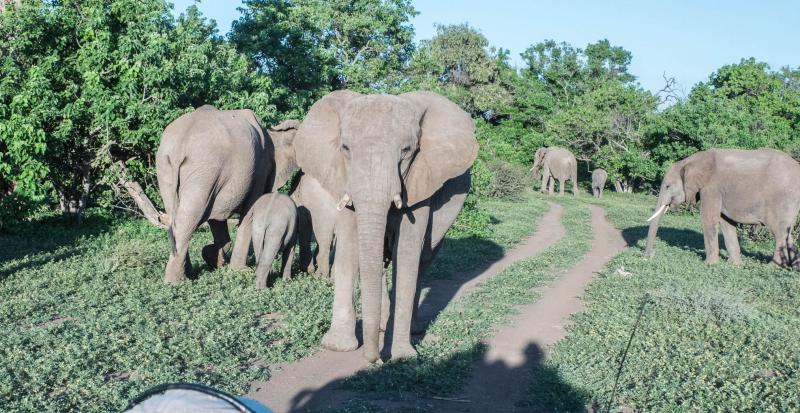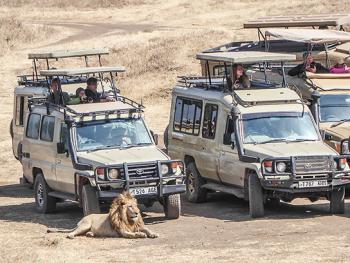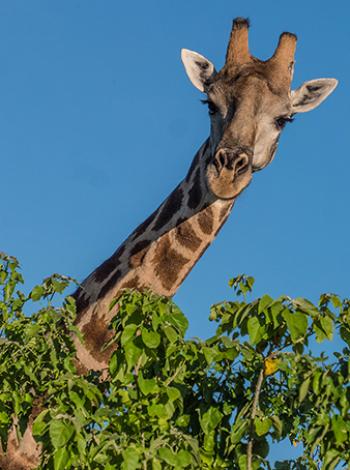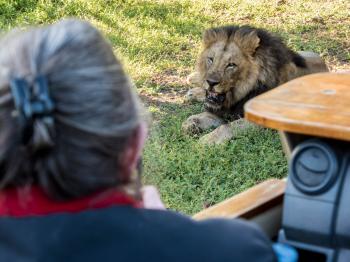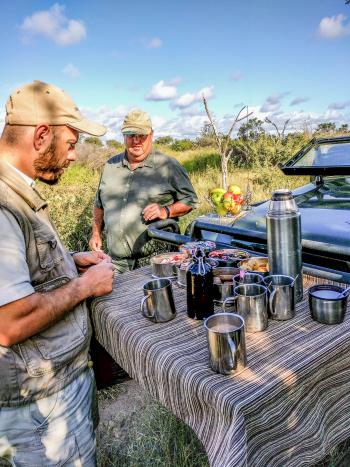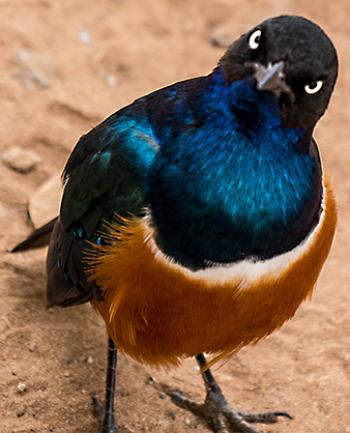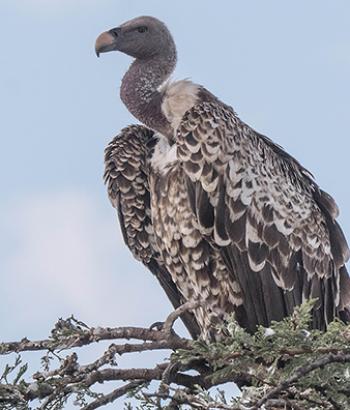A primer on game-drive photo safaris in Africa
This item appears on page 12 of the July 2021 issue.
We returned from our seventh trip to Africa, and our fourth photo safari, in March 2020. This primer is intended to give Africa newbies encouragement and provide some tips for photo safaris.
Our experiences have been in Southern Africa — including the Republic of South Africa (Kruger and Mapungubwe national parks), Zimbabwe (Matobo National Park), Botswana (Mashatu Game Reserve) and Namibia (Etosha National Park and Okonjima Nature Reserve) — and in East Africa, including Tanzania (Ngorongoro Conservation Area and Serengeti National Park) and Kenya (Masai Mara National Reserve).
Except for the great apes, just about any other African animals you can think of are in these places.
•
GAME DRIVES — Game-drive vehicles, in which you go searching for animals, are typically of two types.
Open vehicles (the best) are modified pickup trucks, each with three rows of three stadium-style seats in a pipe-frame structure welded to the back. The best seats are just behind the driver; they provide the best ride and are easiest for getting in and out.
The alternative vehicle is a pop-top Toyota Land Cruiser with three rows of seating in the back. These are often seen in Tanzania and are great transportation but not so great for game viewing and photography. When seated in a Land Cruiser, you’re looking through windows, possibly from a middle seat. With the top raised, the standing room area from which to photograph is limited to two or three people, so you have to take turns.
Unfortunately, you won’t be given a choice of vehicle. Your camp has already chosen one or the other.
Once in any vehicle, you’re there for the duration of the game drive, so there’s really no issue if you’re a bit creaky embarking and disembarking. They will have a step stool or small ladder if you need help.
At each lodge or camp, you’ll probably have two 3-hour game drives per day. The morning drive, just after sunrise, is preceded by a snack and coffee and is followed by an extensive brunch after you return to the lodge. During the midday heat, you’ll be at the lodge for a nap, reading and maybe a swim. (You’re not permitted to wander off on your own. There are wild animals out there, after all!) The evening drive starts about 4 p.m. and ends just after sunset.
Each drive is interrupted once for drinks and snacks. For “morning tea,” the guide and tracker set up a folding table and offer coffee, tea, water and some sort of snack. The evening stop’s offering will include adult beverages and a snack. We’re wine drinkers, but soft drinks, beer and cocktails are also options.
Sometimes there will be a night drive, with the guide or tracker shining a big floodlight looking for nocturnal animals. We have not found the night drives to be very interesting, though one night we spent time in a “hide,” where we watched animals come out to feed on the lodge’s kitchen scraps. That was fun.
THE BIG FIVE — Seeing the Big Five (lion, leopard, elephant, rhino and Cape buffalo) is usually everyone’s goal on an Africa trip. In addition, there is a bewildering array of thousands of antelope, from the tiny 10-pound dik-dik to the huge eland, which can easily reach 1,000 pounds, plus hyenas, jackals, cheetahs…. The list goes on.
No outfitter will promise that you’ll see all of the Big Five, but we’ve done so on all but one trip. The toughies are the leopard and rhino. Another challenge is finding a male lion that isn’t sleeping. (Speaking from personal experience, watching sleeping lions is boring.)
For fun, you can challenge your guide to also show you the Little Five: ant lion, buffalo weaver, elephant shrew, leopard tortoise and rhinoceros beetle.
DANGEROUS ANIMALS —
African animals are highly acclimated to seeing game-drive vehicles and will either ignore them completely (big cats, elephants) or move slowly away as a vehicle approaches (antelope). It can be a little intimidating when a huge bull elephant approaches your vehicle to check out its contents, but don’t worry; you’re safe. Big cats typically show no curiosity at all.
Guests are frequently admonished to stay seated and to keep their arms and legs inside in order to “avoid breaking the outline.” The idea is that animals see the vehicle full of people as one big object that has never provided food, has never taken their food and has never been dangerous for them.
In most cases, animals range freely around the camps, so it is common for management to insist that you have an escort when walking between the central lodge and your tent or cabin after dark. It can be hard for a naïve guest to gauge the danger, though.
(At one camp, we were escorted by a man who “protected” us with a handful of rocks to throw at wandering Cape buffalo. At another, we were escorted by two Maasai warriors whose brightly painted spears sported solid iron shafts — serious lion-killing spears.)
BATHROOMS — Sorry, game drive vehicles are not equipped with bathrooms. You can choose to “hold it” for a couple of hours, utilize behind-the-bushes opportunities at the snack stops or let your driver/guide know that you need to stop so a safe place can be found.
You can buy “camper’s toilet paper” — very small rolls in plastic dispenser pods, sold by Coleman and other camping suppliers. If you use toilet paper in the bush, either bury it or pack it out with you. Small zip-lock bags are good for this. (We carry TP on all trips, not just in Africa, since restrooms anywhere can be short of TP.)
CAMERA EQUIPMENT — If you’re on a photo safari, is a cell phone enough?
For resolution (megapixels) and quality, cell phone pictures are pretty darn good. Holding the phone to take pictures can be awkward, though, and there is often a slight delay between pushing the button and the picture’s being taken. Neither of these is good on a safari. Those darn animals move!
A bigger problem is distance. You’ll often need a zoom telephoto lens in order to get a good picture. Sandra’s solution has been one of the Panasonic “ZS” series compact cameras. She currently has a Panasonic LUMIX DC-ZS70 that fits nicely in her small purse and has an excellent zoom lens. For a non-photographer, a ZS70 or similar, set to use completely automatic settings, would be perfect.
George is a more serious photographer. He carries compact cameras (such as the Panasonic Lumix DMC-GX7, -GX8 and/or -G1) with interchangeable lenses from the Panasonic/Olympus Micro Four Thirds system, which he likes because of its small size and wide variety of available lenses. (Keep in mind that you’re carrying all of your equipment, and there’s not a lot of extra room in the vehicles. You often have only your seat and a very limited amount of foot room.)
Technically speaking, that system’s pictures are superior to Sandra’s images, but most of our images are for photo books documenting our trips or for Sandra’s social media posts. In those cases, there’s no real difference. (Both of our cameras shoot good video, too.)
Do NOT buy one giant memory card, put it in your camera and shoot all of your pictures on it. Cameras can be lost or stolen, and memory cards can fail. George puts each day’s shooting on a separate memory card and never puts memory cards in checked baggage. Cards are cheap; your trip is not.
Carry extra camera batteries and two chargers. If your sole charger dies, you might as well have not taken a camera.
Binoculars are nice if you’re not busy taking pictures. The sweet spot is about 7x32 or 8x32. Larger magnifications (the first number) can be fiddly to hold steady. Larger objectives (the second number) gather more light than our old eyes (with diminished pupil dilation) can use, so they’re just unneeded bulk, weight and expense.
If you’re buying new binoculars, consider the price as a small percentage of the cost of your trip and don’t buy junk. Birder web pages, such as www.audubon.org/gear/binocular-guide, are great for education and shopping. (Our favorite binoculars, unfortunately discontinued, are very similar to the current model Leupold BX-4 Pro Guide HD 8x32mm.)
CLOTHES — Lonely Planet, Frommer’s and other guidebooks, along with some research on climate, can help you select your wardrobe. We have a few suggestions.
First, it can be pretty cold on morning game drives, especially if it’s windy and the vehicle is traveling 10-20 mph. A good windbreaker is the answer, with maybe an extra layer or long-sleeved shirt underneath. A nonbreathable rain jacket can serve nicely too.
Game-drive vehicles are usually equipped with blankets for chilly mornings as well as with rain ponchos. Some vehicles have canvas roofs and roll-down side curtains to keep passengers dry, so you don’t need to take any serious rain gear.
Don’t bother hauling heavy, bulky hiking boots unless you have some special activity planned. Game drives involve little or no walking, so any comfortable closed shoes are fine. Sandals are also OK if you don’t mind gravel, sand and fire ants.
Avoid hairspray, scents and heavily scented sunscreen. These can attract bugs and be offensive to the animals and, perhaps, other travelers.
We’d be happy to answer questions via email, phone or even video conference. Contact us through ITN, please (editor@intltravelnews.com or c/o ITN, 2116 28th St., Sacramento, CA 95818).
GEORGE & SANDRA ANDERSON
Minneapolis, MN

